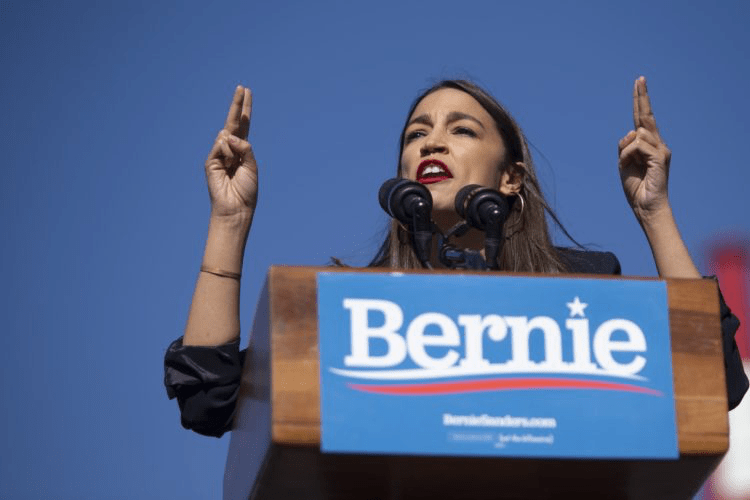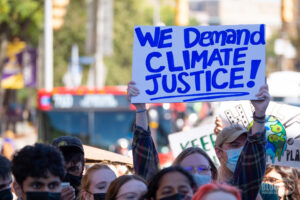The Radical Vision of a ‘Homes Guarantee’ for All
An ambitious new plan aims to combat the growing housing crisis across the country on multiple fronts, and its creators are thinking big. Rep. Alexandria Ocasio-Cortez, D-N.Y. (Eduardo Munoz Alvarez / AP)
Rep. Alexandria Ocasio-Cortez, D-N.Y. (Eduardo Munoz Alvarez / AP)
In late September, New York Democratic Rep. Alexandria Ocasio-Cortez unveiled The Place to Prosper Act, one plan out of a larger policy package called “A Just Society,” dedicated to protecting and enforcing tenants’ rights. That same month, before the introduction of that plan, Democratic presidential candidate Sen. Bernie Sanders had released his own housing plan to address this country’s growing housing crisis through such proposals as a national rent cap and a $70 billion investment into public housing.
But before these two progressive leaders publicized their plans, a grassroots coalition of affordable housing advocates came out with its own housing policy, called a Homes Guarantee, dedicated to eradicating homelessness and providing affordable, sustainable housing for all Americans.
At its core, the Homes Guarantee seeks to tackle the growing housing crisis in large cities and small towns across the U.S. by decommodifying housing and divorcing the need for housing from its current market-based, capitalist-driven system. To accomplish this, the Homes Guarantee calls for building 12 million new social housing units—a public option for housing, in which rents are set at below-market rates—over the next 10 years and offering at least 600,000 “permanent supportive housing” units, which combine affordable housing with social services to help people who face chronic homelessness. The plan also calls for a $30 billion reinvestment in public housing over the next five years, a stark contrast to the federal government’s massive disinvestment in public housing over the past few decades.
While the left has seen bold visions in the form of the Green New Deal and “Medicare for All” to address the climate crisis and health care, respectively, it hasn’t yet seen a similar plan or movement to address the housing crisis in the U.S. The coalition behind the Homes Guarantee hopes to change that.
“We want it to be in the same string of other progressive demands, like Medicare for All, Green New Deal,” said Tara Raghuveer of the grassroots movement People’s Action, who helped put the plan together. “We think it is that vision—what is the boldest set of structural reforms? It’s a Homes Guarantee.”
The publishing of the Homes Guarantee, in addition to Ocasio-Cortez’s Place to Prosper Act and Sanders’ plan, reflects a growing effort by grassroots advocates to demand more political action addressing the housing crisis impacting millions across the country.
According to a 2019 report from the National Low Income Housing Coalition, a person earning minimum wage working 40 hours a week would not be able to afford a two-bedroom apartment in any county in the U.S. without feeling cost-burdened. The report also found that there is a nationwide shortage of about 7 million affordable homes for low-income renters, and that nearly 50% of renters spend more than 30% of their income on rent alone. Major U.S. cities are also facing a growing homelessness crisis: In Los Angeles County, for example, homelessness increased by 12% over the past year, putting the county’s homeless population at 58,936.
If implemented, the Homes Guarantee would make a serious dent in the housing and homeslessness crisis impacting millions across the country. That reality is not lost on those who worked on the policy plan, many of whom have or are currently experiencing homelessness or housing insecurity themselves.
For Linda Armitage, a housing advocate in Chicago who worked on the project, a Homes Guarantee would have saved her from the stresses and trauma of organizing against the greed-driven developers that took over her building. In describing the management’s lack of care for residents, she said that when she told them about a broken elevator in the building, hours before a doctor’s appointment, management suggested she go down the stairs backward on her rollator [mobility walker] instead.
“They’re fine for collecting the rent, making sure the buildings don’t fall down around their heads,” Armitage said. “But … especially as far as seniors are concerned, they have no clue about the special needs that seniors have.”
As a member of Jane Addams Senior Caucus, a Chicago-based grassroots organization working on economic, social and racial justice for seniors, Armitage has seen the ways an unstable housing market hurts seniors like herself. She said a Homes Guarantee would ensure that people like her would not have to worry about losing a stable place to live.
“The seniors don’t want to worry about, ‘Am I going to be homeless?’ like we did here when our building was almost sold out [from] under us,” she said. “They have a right to live with dignity and in good mental and physical health.”
The grassroots coalition and policy team behind the Homes Guarantee made sure the plan also addresses the other issues connected with the housing crisis, particularly the impacts of climate change. One of the goals of the Homes Guarantee emphasizes green construction to “drive deep decarbonization, develop workers’ skills in low-energy construction, and … lower costs of energy efficient appliances and materials for all consumers.” The plan also demands that new housing units be built near public transit and that existing public housing be retrofitted to include energy efficient appliances.
Daniel Aldana Cohen, a sociology professor at the University of Pennsylvania, listed three priorities for integrating the Homes Guarantee with a plan to address the climate crisis: driving down carbon emissions, tackling racial and economic inequality and prioritizing the comfort and safety of the people living in their homes.
“So I think that if you want to really change the way that people live for broader environmental goals, and if it’s possible to make that consistent with an improved experience in the home, then you have to foreground that,” he said.
Cohen added that emphasizing the comfort factor of residents can also influence the decarbonization of the economy, a primary goal of the Green New Deal. The Homes Guarantee recommends regulations and public procurement in the construction of new social housing units to decrease the cost of low-carbon concrete and conducting energy retrofits in existing public housing as ways to slash carbon pollution over time.
Another climate justice goal of the Homes Guarantee is to ensure that public housing residences can also function as climate resiliency centers, in which communities can feel protected in the event of increasingly devastating natural disasters. In practice, this can mean providing food and water during intense storms and having plants powered by clean energy to ensure electricity during power outages.
“We’re really trying to concretize what it means to do inequality and climate change at the same time,” Cohen said. “I think it’s sort of hard to overstate how important it is to us that we finally make very specific and clear and concrete how a Green New Deal can tackle inequality and carbon at the same time.”
The Homes Guarantee is also dedicated to providing reparations to communities for centuries of racist housing policies. The plan discusses how redlining and exclusionary housing policies like racial covenants barred black people and indigenous communities from the opportunity to own a home and live in safe, affordable housing.
Sofia Lopez, a senior research analyst at Action Center for Race and the Economy, worked on the reparations portion of the plan. Yet Lopez said a blanket homes guarantee to all people is still not enough to address that history of systemic discrimination.
“The history of housing in our country has always been racist,” she said. “People have not had equal access to housing. We talk about that like it’s all ancient history, but it isn’t. I can’t think of any city that isn’t hyper-segregated.”
Lopez has seen how housing policy has intimately impacted people in her hometown of San Antonio, where heavy investment in developing the downtown area has caused property values to skyrocket for the surrounding neighborhood. This increase in property values, Lopez said, has become a strain on communities of color in San Antonio.
“Say you have a family that’s owned [its] home for a generation or two or even less than that,” she said. “If [its] still making the same income and [its] required to pay higher property taxes, there’s all kinds of opportunities for that home to be taken away.”
To help the black and brown families who are still in financial ruins after being targeted for subprime mortgages by predatory lenders during the 2008 housing crash, the Homes Guarantee recommends either canceling their debts altogether or drastically reducing their outstanding balances.
“I feel like we should be at a point where we can say that … banks should not continue to profit off of the fact that there are people that are still in debt because of the awful predatory lending that was taking place during that period,” Lopez said.
And while the plan does not try to emphasize home ownership at the expense of guaranteeing housing as a basic necessity, the Homes Guarantee does recognize the need to support black and brown households through “grants and zero interest capital so they may pursue self-determination in securing housing that meets their needs.”
The passing of a true Homes Guarantee faces a steep uphill battle, largely because a plan of its kind—that proposes to end homelessness, divorce housing from capitalist interest and provide safe and affordable housing to all Americans—has not been a serious consideration in mainstream politics for decades. The last time housing policy was taken seriously in the U.S. was during Lyndon B. Johnson’s presidency during the civil rights era, when the Department of Housing and Urban Development became a Cabinet-level agency in 1965 and the administration passed the Housing and Urban Development Act in 1968.
Now, in 2019, with millions of people across the U.S. facing a housing crisis, a housing guarantee policy is long overdue.
“We’re nearing a breaking point,” Raghuveer said. “There are more renters than ever, there are more cost burdened renters than ever. People are literally being displaced across the country. Climate change is adding another layer to this, where we have climate refugees within our own borders.”
One large obstacle facing the Homes Guarantee will be convincing politicians and the public to think about housing not as a capitalist commodity or something to be owned, but as an inherent human right.
“There is a tension between property ownership as a tool to build wealth and a Homes Guarantee as kind of unpacking some of the privilege that we put on property ownership as a tool to build wealth,” Lopez said. “I think our philosophy really has gotten us into the situation that we’re in.”
That philosophy, which is very much guided by a combination of capitalism and racism, has also contributed to the lack of political will and imagination to pursue a federal housing policy. Raghuveer said what makes housing unique from an issue like health care is the way home ownership is so intimately tied to the Western mythology of wealth building and the American Dream: “My family are immigrants and completely bought into that myth,” she said. “And I think there’s still a lot of working class people who, by no fault of their own, have bought into this dominant narrative that if you work hard enough, one day you too can own a home and that’s the thing to aspire for. And what that’s led to is a complete lack of imagination around what’s possible. In the American dream mythology … a single-family home is the way you build your family’s wealth even though that’s never been the truth for most people by right and by design.”
Raghuveer added that the stagnancy on behalf of politicians to address this country’s housing crisis is, in part, done on purpose.
“They’re not ignoring this issue just because,” she said. “They’re ignoring this issue because, in ignoring it, people benefit … lobbyists, [real estate] associations, big developers, massive corporations, private equity, Wall Street—there are worlds and worlds of people who benefit from people being homeless, people dying on the streets, people not being able to afford their rent.”
Then there’s the stigma—developed and maintained by political demonization of the poor and by racist dog-whistling—that treats public housing as a scourge on society rather than a public good. The proof is in the ways both Republican and Democratic administrations in modern U.S. history have declined to fully invest in social services that would help the poor and working class.
“There has been a very successful bipartisan campaign to demonize the role of the public sector in providing housing,” Raghuveer said. “The stigma around public housing is so strong, not because public housing was actually a failure, but because the private market now benefits from us not believing in a public option for housing.”
While mainstream politicians may continue to ignore the growing housing crisis in the U.S., advocates backing the Homes Guarantee, like Armitage, believe passing such a plan can be done.
“We can spend millions, billions, trillions on the military, on war in general,” she said. “There’s no reason we cannot come up with a way to give people housing as a human right and give people a guarantee. It can be done.”
Your support matters…Independent journalism is under threat and overshadowed by heavily funded mainstream media.
You can help level the playing field. Become a member.
Your tax-deductible contribution keeps us digging beneath the headlines to give you thought-provoking, investigative reporting and analysis that unearths what's really happening- without compromise.
Give today to support our courageous, independent journalists.






You need to be a supporter to comment.
There are currently no responses to this article.
Be the first to respond.